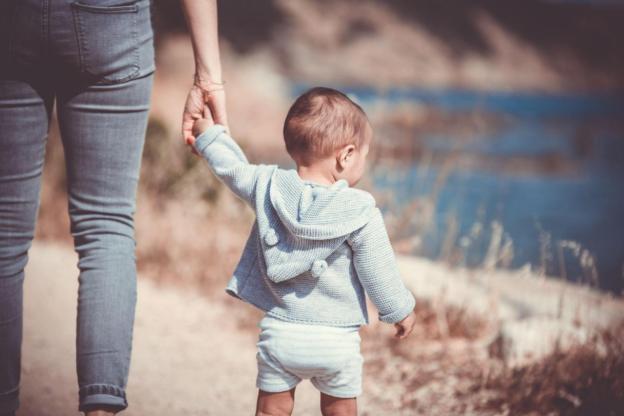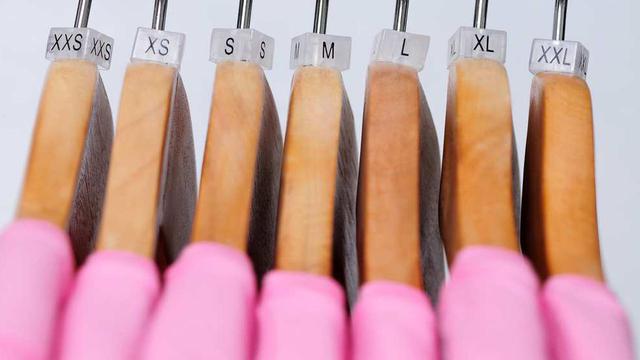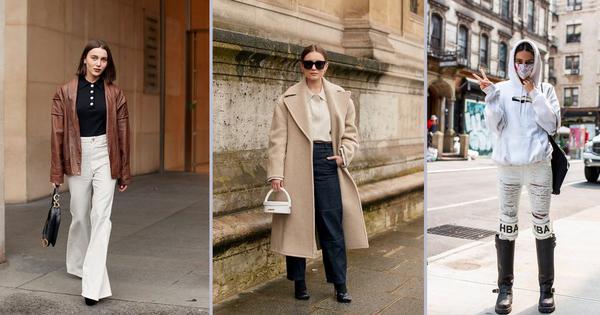
In France, almost half of women are 44 or more. And yet, few of them find clothes in their size in stores. Shunned by the big brands, these French women are therefore forced to spend a large part of their shopping budget on foreign websites (Asos, Forever 21, Dorothy Perkins etc.) "while we would like to do it in France", pleads Gaëlle Prudencio, blogger of The Curvy and Curly Closet. A paradox in the land of fashion?
If, all over the world, France is famous for its big brands, it seems to have forgotten to look into the “large sizes”. Yet every year, INSEE tells us that French women are growing, growing, that the curve of obesity is growing. And that “the average corpulence increases more and more quickly”.
Problem: in shopping centers in France, due to a lack of supply, these customers are forced to buy “what they can, not what they want”, denounces Catherine Lemoine, editor-in-chief of the Ma Grande Taille site. . Same observation for Mathilde, singer: “It's the cross and the banner to find a garment that fits and with which you are completely satisfied”.
“In France, it's not like in the United States where supply meets demand. Here, there is still a barrier”, compares Mathilde. An opinion shared by Chris Carvillo, stylist and host of the program “Belle Tout nue” (M6): “The clothing offer in France is poor for different sizes. It's not even the sizing proposal that's unfortunate, it's the aesthetic proposal”.
Numbers
According to figures from the latest study by IFTH (French Textile Institute - Clothing), nearly 45% of French women are a size 44 and above. This estimate seems to correspond with the figures of the latest MGEN/OpinionWay survey according to which 30% of French people are overweight, and 16% obese.
How can the country of Haute Couture lack aesthetics? “The fashion has turned into 36, 34 or even 32. In the rounds, we don't offer them anything, observes Chris Carvillo. But it is a second suffering not to be able to express oneself through clothing. There are whole sections of the population completely forgotten,” he says.
Not being able to dress: a real pain
For many, getting dressed is a pleasure, a hobby. Conversely, “you can't imagine how tragic it can be for a woman not to be able to dress as she wishes,” reports Catherine Lemoine of Ma Grande Taille.
Considering herself a “body positive activist”, Gaëlle Prudencio, the blogger of The Curvy and Curly Closet, organized a conference last March on “fashion and the weight of appearances”.
There, Chris Carvallo traced the course of clothing in our society: it first embodied a social representation, then became an industry, and now, a personality in its own right. “Today, we dress to hope to send a message: we play with a language of dress,” he explains.
In fact, "it's all the more difficult to take a position through the garment, when there is no garment in one's size", says Mathilde, who says "dream of the garment, of the beautiful object, the one that goes go away. I'm tired of trying to fit into clothes, I want the clothes to fit me”. To compensate for this lack of supply in France, the singer is now investing in made-to-measure clothing.
Overweight, a factor of discrimination, especially for women
Beyond being a suffering, the fact of not being able to dress properly when one is overweight generates discrimination... And not just anywhere: at work.
According to the latest survey on discrimination by the International Labor Organization (ILO) and the Defender of Rights, women are the first victims of discrimination by appearance when hiring (10% of unemployed women, against 6% unemployed).
Added to this is the weight. Obesity is particularly discriminating: “33% of the unemployed people concerned say they have already been confronted with questions related to their corpulence”, underlines the study. But the feeling is disproportionate between men and women: 13% of unemployed men in this case say they have been discriminated against against 30% of unemployed women.
And among unemployed women, “obese women are eight times more likely than women with a normal body mass index to report being discriminated against because of their physical appearance”.
Why ? “As a plump woman, I am not forgiven anything, explains Catherine Lemoine. When I leave home, I have to be impeccable, otherwise I stick to the misconception that I am fat, so I let myself go”. A vicious circle that is hard to break.
An observation shared by Mathilde who, for job interviews, has already had to spend small fortunes to find the appropriate clothes. “But when you're looking for a job, logically, you don't have a lot of money. It is therefore a penalty”.
Danielle Ahanda, creator of the webzine Afrosomething, says to herself “at the crossroads of several forms of discrimination: I am black and fat. I can have an employer who is not racist, but who is not going to hire me because I am fat”, she laments.
The weight of the collective unconscious
For Danielle Ahanda, the importance of sizes in the collective unconscious can explain this problem. “There is the weight of the size, she explains. Me, I don't care about the number on the label, as long as I'm comfortable. So sometimes I buy two sizes up. But for many people it is unthinkable”.

How to Become a Certified Registered Nurse Anesthetist (CRNA) https://t.co/xgs06sFmM5- should Alberta start a program? @shandro
— Michael Zuk DDS Fri Sep 18 01:11:35 +0000 2020
Same approach for blogger Gaëlle Prudencio: “It's really very important to accept that size is just a number on a label. Me, depending on the brand, I'm between 44 and 62!”. However, size is often seen as a threshold. “If a woman reaches size 40, she will say to herself: “I have to lose weight”, observes Danielle Ahanda.
Another belief, according to Catherine Lemoine, “in the collective unconscious, a fat person is in transition into a fat body. He necessarily tries to lose weight and his priority is not to dress. So fat fashion is a non-issue”.
And then there are the brands where curvy women know they are not welcome. Brandy Melville and Abercrombie & Fitch, for example, are publicly accused of discrimination. “Today, many brands give the impression of displaying 'No fat people' on their storefront,” denounces Mathilde.
online community
Over the past five years, the democratization of plus-size fashion bloggers has, however, shifted the lines. Ligaurine Verdière, a saleswoman at one of Paris' very few multi-brand boutiques, Women Curves, observed this change: “I was in plus size fashion 10 years ago, and it wasn't like that. These bloggers started wearing bolder pieces, crop tops, colors, patterns, and they made other women think, 'Why not?'”.
A real alternative network has developed on the web. Because finding certain items in stores such as boots, lingerie, jewelry, or tights proved to be very difficult. “We have to go and scrutinize the blogs, to find out where what is sold”, explains Mathilde.
Some fashion bloggers
> Gaëlle from The Curvy and Curly Closet > Sihem from Curvy Mood > Anaïs from Anaïs Pénélope > Ninah from Ninaah Bulles > Caroline de Boaimes tips
Today, several platforms bring together large communities. Like Ma Grande Taille and its average of 800,000 unique visitors per month. The site, which has existed since 2008, now employs a dozen people, and has released its own app. “Initially we only talked about fashion then, little by little, we opened up to everything that could concern curvy women, says Catherine Lemoine. We want to reach out to all the women that brands don't reach out to, and change that”.
Militant fashion?
Like the blogger Gaëlle Prudencio, like the Ma Grande Taille team, many plus size fashion players evoke the notion of commitment, even of combat. Patricia Gordon, who opened the first Women Curves multi-brand store a year and a half ago in Paris, is indeed encountering certain difficulties, in particular in finding suppliers - there are fewer of them - and “installing the concept”.
“Economically, making this niche profitable is not easy either, she admits. In general, it's really an environment where there is no money, she notes. The majority of people who promote plus size fashion do it alongside their work, it's almost activism”.
“We are not recognized by the profession”
Among these women who are moving the lines of plus size, there is one man: Olivier Wartowski, a Paris-based designer who, in the words of Patricia Gordon, “fights to be daring”.
It was after reading an article on the market share of plus size fashion that Olivier Wartowski decided, a season and a half ago, to launch his own brand. He also perceives the human aspect of his work: “It's fantastic to evolve in this environment, because I really feel like I'm contributing something when I see the smiles of the customers who come to the shop. We have a great comeback.”
Some French creators
> Chiffons de Paris, from 42 to 56> Courbes & Co, from 42 to 58> Jiuly, from 42 to 54> Pauline and Julie, from 36 to 54
The problem, “is that we are not recognized by the community, in particular by the Federation [French of Couture, Ready-to-Wear, Couturiers and Fashion Designers] which does not grant us subsidies despite my requests, nor even help in taking out loans from the banks. Everything is long, tedious,” he laments.
In Berlin, at the Curvy is Sexy trade show, Olivier Wartowski won the prize for best “plus size” designer for his previous collection. But, in France, it comes up against a blockage. “In Paris, plus size fashion is not fashionable. This blockage is very ideological, they do not want to mix things up”, he regrets. Yet “these are huge market shares that brands are missing out on”.
The brands that have invested
However, not everyone has missed out on plus size fashion. In France, the big names in the sector are called Kiabi or La Redoute. “Our interest is to offer the same fashion as to women who wear 36”, explains Christelle Vincent, Category Manager plus sizes at La Redoute.
“After a market study, we found that the plus size offer was very poor - in number and in style. We have counted that where 100 products are offered to a woman who is 38-40, there are only 30 offered to a woman who is 46. And these are not the most glamorous”, develops t -she.
In the offices of La Redoute, “three product managers and three stylists work full-time on the subject” (Castaluna and Taillissime), indicates Christelle Vincent. And large size sales represent a quarter of sales, “which is in line with the French population”, she argues, “since 30% of women are 46 and over”.
According to the figures she has, 60% of women are 42 and over, “the majority is there”. With such data, why haven't more brands entered the sector? “I seriously think it's ideological. Because they are all aware of the potential, and business calls for business”.
On the side of Kiabi, about fifteen stylists work on large sizes. "It's really not a sector that is underestimated," said Meritxell Lopez, one of them. Moreover, Kiabi has recently developed a new large size brand, “Size+”, which is aimed at children. Proof, if any, that demand is growing among the youngest as well.
The return to the store thanks to the internet
Today, the challenge is to bring back to the cabins the customers withdrawn on the web. And many have understood this. This blockage so far in France, “the web is in the process of breaking it”, notes Christelle Vincent, from La Redoute.
"The clients, we will look for them on the internet", explains Meritxell Lopez. “Because there is a demand for advice and proximity”. At Kiabi, customers can make an appointment on Facebook with a “fashion coach” who will offer advice during a chat. And to really bring the customer back to the store, there is also an e-reservation system, then a visit to the store.
Same strategy - on a smaller scale - for Olivier Wartowski. “The majority of women prefer to stay hidden on the internet. As a result, I developed the Shop2cam.com technology thanks to which you can browse the site while being in videoconference with the store. There, a saleswoman can present the clothes and try them on for the customer”. This trick, halfway between online sales and brick-and-mortar stores, “gives customers a lot of confidence, and it works very well, I've never had any product returns,” observes Olivier Wartowski.
At Women Curves, we mainly play on the online community to attract customers. “Social networks are an integral part of our communication”, explains Patricia Gordon. But “our principle is to go the opposite of online sales. Precisely because our strength is proximity, advice. How many customers come here thinking they're doing a 56, and leave with a 46?” she points out.
Advice and fitting are a key phase of the buying process in plus size fashion, because the more you go up in size, the more the tailoring is technical. Which is also one of the reasons why not all brands come up against it. At least for now...
From Women Curves to bloggers, via Olivier Wartowski, many “little ones” get involved. “But we are not helped”, deplores the French designer. For Ligaurine, saleswoman at Women Curves, “it's also up to all these big brands that have the money to make things happen”. Some have realized this. At La Redoute, Christelle Vincent observes a phenomenon: “I have never been interviewed so much on the subject of large sizes as this year. There is something moving”.
Pulp Fashion Week
This fashion week dedicated to “plural fashion” was created by Blanche Kazi four years ago. It is held in Paris on May 6, 7 and 8. About twenty brands are represented, on the podium as well as on the stands, and international models have made an appointment there.







